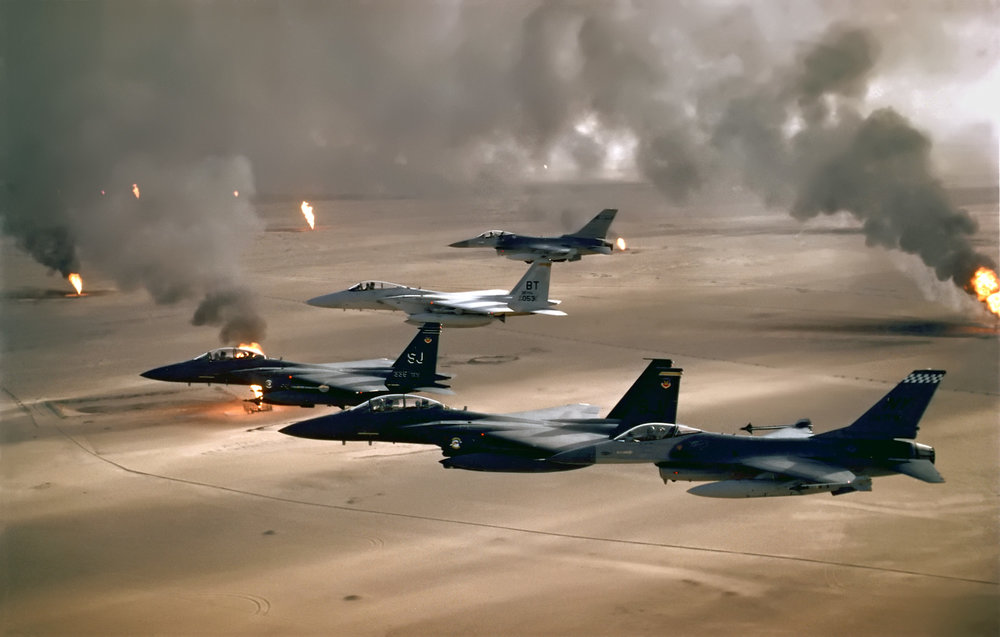After writing a doctoral dissertation examining the relationship between doctrine, strategic policy and military culture; then working as a doctrine developer for almost seven years while concurrently authoring a dozen books, monographs and peer-reviewed journal articles about doctrine, I am finally bold enough to assert that I may know a little bit about it. Recently, my research focus has moved on to other, albeit related, topics. When musing over this change in focus with a colleague, they challenged me to summarize my thoughts about doctrine in a thousand words. Specifically, they said I’m too verbose and therefore wouldn’t be able to do it...
…and they were right! So, what follows is 1,500 words summarizing what I have learned about the nature of military doctrine over the past decade.
WHAT IS DOCTRINE?

A company of Marines participate in a training march on Feb. 22, 2013 at Camp Lejeune, (N.C. Scott Olson/Getty)
If I were compelled to define doctrine in a single sentence, that sentence would be: “Doctrine is a tangible representation of a military’s institutional belief system regarding how that military understands, prepares for and (in theory at least) conducts military activities.” To this general definition, which is derived from that contained in an earlier and more comprehensive study, some caveats must be added.
First, doctrine differs from theory because it is institutional. Even if a significant minority of the institution’s members disagree with doctrine, it nevertheless remains a representation of a military’s institutional beliefs. The official endorsement and institutional attribution of doctrine manuals symbolize this. Second, contemporary doctrine takes the form of written manuals. This was not always the case (see below), however when most people think of doctrine today, they think of written tomes. This is because written doctrine has become commonplace in Western militaries, and is the most visible type of doctrine. Finally, doctrine is cognitive in nature, since it is both part of and the result of a process of knowledge acquisition, assessment and distribution. Doctrine is inherently subjective because its content reflects a belief system. By making this system, or at least parts of it, tangible, doctrine is by necessity simplified and can only ever present an incomplete representation of strategic, operational and tactical realities.
WHAT IS DOCTRINE’S HISTORY?

Then-President Barack Obama greets members of the audience following his remarks at an event with military personnel at the Pensacola Naval Air Station in Pensacola, Fla., June 15, 2010. (White House Photo)
Written doctrine has not always existed within armed forces; however, the belief system underlying it has always been a part of military culture. This is due to the inclusion of the word ‘tangible’ in the above definition. Doctrine does not necessarily need to be written down, but it does need to be proclaimed in some way so as to be accessible by members of the institution. Non-written doctrine may therefore include pedagogical syllabi, acquisitions preferences, force structure development, or even stylistic penchants regarding military uniforms. Yet, today, written doctrine is the most accepted form of doctrine within Western militaries. This type of doctrine has a history of about four hundred years; its earliest predecessors being drill manuals. Over time, doctrine gradually expanded from drill to tactics, then to operational, and ultimately strategic matters. The expansion of written doctrine accompanied the progressive institutionalization, regulation, professionalization, and bureaucratization of Western militaries. The history of written doctrine is therefore reflective of the evolving relationships between militaries, states, and their populations, in addition to reflecting broader intellectual and scientific trends.
WHAT INFLUENCES DOCTRINE?
The figure below shows the major influences on, and key intended effects of, doctrine. This figure is based on the findings of a study of doctrine development in all three services and jointly in Australia, Canada, and New Zealand over a 20-year period beginning in 1987. As the figure illustrates, doctrine has a diverse mix of influences. It is, in turn, intended to play one or more of several roles, and it is always a product of the broader cultural, political, social and environmental context in which it is developed—all elements of the ultimately intangible belief system discussed above. Importantly, this context is influential even if doctrine developers are not consciously aware of it
The only additional factor not included in the figure is the role of the doctrine writers themselves. They are often subject matter experts but they may sometimes be “subject matter expert[s] by virtue of posting,” which can be detrimental to doctrinal quality. Furthermore, knowing about a subject discussed within doctrine and being able to write a doctrine manual require two different skill sets. A practitioner only needs the former skill set, however a doctrine writer ought to have both. If a doctrine manual is poorly written, perhaps the writer simply does not know how to express his or her knowledge well in writing.

WHAT IS DOCTRINE DESIGNED TO DO?
The answer to this question is also illustrated in the above figure. Interestingly, the same study found that across several nations, navies tend to focus more prominently on the blue sphere shown at the top of the figure (can contribute to military strategy); armies on the sphere shown on the left (guidance for operational and tactical activities); and air forces on the sphere shown at the bottom (delivery of professional military education), in particular regarding the importance of air power and institutional independence. Of course, this prominent focus is not to the exclusion of some level of focus on the other areas, and joint doctrine roughly focuses equally on all three. All services, as well as joint doctrine, tend to incorporate aspects of what is shown in the blue sphere at the right as well (institutional analysis of operational challenges). The study demonstrated the institutional belief system of each service shapes what is manifested in its doctrine, and a link can therefore be made between doctrine and differences in service cultures observed in sociological studies of the militaries of the US and Canada.
WHAT HAPPENS WHEN DOCTRINE GOES WRONG?
Putting doctrine into written form and publishing it can only capture a snapshot of a component of a military’s belief system at the time of publication. Like a Polaroid, a doctrine publication cannot fully show the entirety of the situation at the time it is developed, nor can it fully capture the present state of affairs, even moments after its development. Furthermore, doctrine cannot give context to itself. The cultural, political, social and environmental factors mentioned above are necessary to create context, and understanding doctrine requires an understanding of context.
When doctrine goes wrong—in other words, when adherence to it leads to sub-optimal outcomes, or even to outright military failure—it is often because of one of two reasons. First, the doctrine has provided the wrong guidance, perhaps because the belief system underlying it has not considered several important environmental factors. Here, the doctrine is like a photo of a small piece of a machine, which gives the practitioner no idea about what the machine itself may be. Second, the doctrine has provided the right guidance but at the wrong time, perhaps because the institutional belief system was ill-suited to the circumstances in which the institution was conducting its activities. Here, the photo is an old black-and-white family portrait that cannot be re-created today. A real-world example of the first of these situations is the dissonance between tactical success and the doctrine underlying it, and strategic failure during the Vietnam War. An example of the second is the attempt to apply the 2006 edition of FM 3-24 in Afghanistan after that doctrine had proven successful in Iraq during the surge.
BY BLAMING DOCTRINE FOR MILITARY SHORTCOMINGS WE (OFTEN UNWITTINGLY) SHIELD OUR BELIEF SYSTEMS FROM DEEPER SCRUTINY.
It must also be remembered that the manifestation of both of these reasons is entirely context-dependent and, as the ancient proverb goes, “you cannot step into the same river twice.” More often than not, it is only with the benefit of hindsight that we can see what went wrong in a military endeavor, at which time doctrine often becomes a convenient scapegoat precisely because it is tangible, whereas the belief systems which underlie it are not. By blaming doctrine for military shortcomings we (often unwittingly) shield our belief systems from deeper scrutiny.
WHAT HAPPENS WHEN DOCTRINE GOES RIGHT?
The development and subsequent application of doctrine can, on rare occasion, have spectacularly successful results. Such examples include the U.S. Army’s AirLand Battle doctrine that arguably contributed to victory in the 1990-91 Gulf War; and the Australian Army’s “Military Operations in the Littoral Environment” doctrine that arguably contributed in much the same way to the success of the International Force in East Timor (INTERFET) in 1999-2000.
In both of these cases, the doctrine seemed to have set the military up for success in the near future after its release. The doctrine was sufficiently broad as to be holistic in approach (i.e. it contained an operating concept for an entire Army, not just one aspect of its tactical action) and it was also future-focused within a short timeframe (about 2-3 years), enabling short-term army transition to a preferred operational approach. Yet, despite the credit given to these doctrine publications at the time of the campaigns they influenced, with the benefit of hindsight a broader range of factors (in addition to doctrine) have been identified as contributing to success in both the Gulf War and INTERFET. These factors include environmental and other circumstances beyond military control (adversary actions foremost amongst them). In addition, the extent of the success itself has been subject to scrutiny. This indicates a broader doctrinal issue: doctrine is just one of many variables that all contribute to a military outcome. Getting doctrine right can help to achieve military success, but the nature of the underlying belief system and the environment into which the doctrine is placed are both much more important than the doctrine itself.

USAF aircraft fly over Kuwaiti oil fires, set by the retreating Iraqi army during Operation Desert Storm in 1991. (USAF Photo/Wikimedia)
CONCLUDING THOUGHTS: OF BABIES AND BATHWATER
Doctrine, in its modern form, consists of series of written manuals that, together, are representative of a military’s institutional belief system. For all that I have learned about doctrine over the past decade, the most important thing is that whatever the pros and cons of doctrine itself may be, the belief system underlying it and the broader context in which the doctrine exists are much more difficult to perceive, study and understand; yet both are also much more important. No study of doctrine can be complete without taking these factors into account.
No comments:
Post a Comment